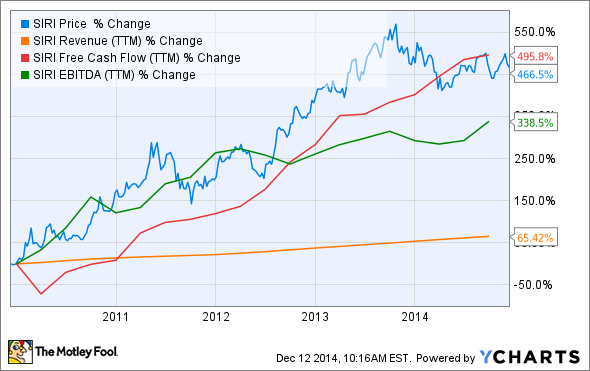Every company has one number that defines its success more than any other. For Sirius XM (SIRI), the world's leading satellite radio service, that number is ...
$11.40
That number was Sirius XM's average revenue per user (ARPU), less customer service expenses, for its most recent quarter. This is the highest figure Sirius XM has ever recorded, surpassing the old record of $11.38 set in the fourth quarter of 2013. Let's take a closer look at this important metric:

Sources: Sirius XM earnings reports
While Sirius XM hasn't always managed to keep its net ARPU on an upward trajectory, the overall trend is decidedly positive. The growth of net ARPU hasn't been rapid by any means, as the third quarter saw only a 1% year-over-year improvement against 2013's result, a 3% improvement over 2012's result, and a 6% improvement over the same quarter in 2010. However, Sirius had 35% more subscribers in the third quarter of 2014 than it did in the third quarter of 2010, which has helped push overall subscriber-based revenue up by 47% in 2014's third quarter as compared to the same period in 2010. This matches up closely to Sirius' five-year revenue growth of 65%, but since each new customer costs Sirius XM a little bit less to maintain. Its bottom-line metrics have taken off:
Sirius XM was barely breaking even at all five years ago on a GAAP basis, but it's been consistently profitable on both EBITDA terms and in terms of free cash flow, the latter of which has so neatly tracked the company's share-price growth that it's become a sort of barometer for future gains. So long as Sirius XM's free cash flow continues to improve over the long term, its shares are likely to keep moving higher as well. A capital-intensive company like Sirius XM will have a lot of things to write off, which will improve its cash flow picture in ways similar to what you might see on a major telecom's reports. However, no amount of write-offs can paint a nice picture on top of bad fundamentals, and Sirius XM's operating margins show an impressive fundamental improvement -- it's nearly three times higher today than it was five years ago:
SIRI Operating Margin (TTM) data by YCharts
Investors shouldn't expect more than modest improvements in Sirius XM's net ARPU going forward, but it's important to remember that this growth works in synergy with subscriber growth. Sirius' subscriber gains have slowed this year, but it seems reasonable to expect between 4% and 5% year-over-year growth in this metric going forward.
Sirius' full-year guidance calls for 1.5 million new subscribers by the end of 2014, which would bring the total above 27 million for the first time ever. Another 1.5 million new subscribers next year would push Sirius' total up to 28.6 million for a 5.5% growth rate. Adding another 1.5 million in 2016 would bring Sirius to 30 million subscribers for a 5.3% improvement over 2015's hypothetical total. At this size, every additional penny of net ARPU gives Sirius XM hundreds of thousands of extra dollars to save or spend on its own growth every quarter. Five cents more per subscriber works out to millions over the course of an entire fiscal year.
Investors have other things to keep an eye on, of course. Sirius XM's operating margin growth has stalled out this year after impressive growth in the first few years of the postcrisis era. The company has doubled its long-term debt load since the start of 2013, and heavy debt burdens were a huge problem for the company during the crisis years. However, Sirius XM's ability to grow sustainably will hinge in no small part on its ability to serve more customers more profitably, which is why investors should keep an eye on net ARPU going forward.







